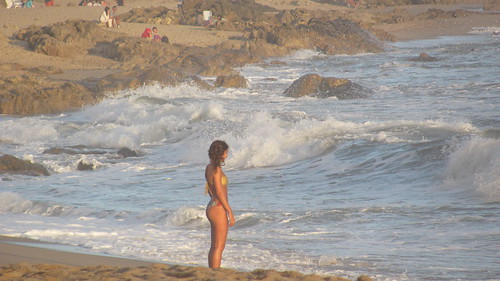 |
| Beauty and the Beach |
When we first stepped out of the bus terminal in Montevideo, and after we had walked along the green-painted sidewalk comically noted for tourists, when we got out to Rambla Franklin D. Roosevelt in search of a cab that would take us to the Tres Cruces bus terminal a couple of miles away, we were happy that we had decided to skip the capital of Uruguay in favor of the white sandy beaches of Punta del Este up north.
I fully admit that we didn't get to see the old part of town, which, as one friend described to me, is well worth the visit. I've heard that the Rambla Sur is incredibly pretty, too, but let's face it, what we saw on the bus ride north and the bus ride west - two ends of the city from near the center - was not worth sticking around for. In fact, what I saw made me rather angry: where was all the money from Punta del Este being spent?
 |
| Montevideo |
Punta del Este is a playground for the rich. It is South America's version of the French Riviera, and for good reason, too. It's beaches are pristine on both sides of the peninsula: The surfers rejoice on the windward side while those in need of relaxation snooze away on the leeward side. The villages around Punta, too, all also offer excellent cuisine, night-life options, day-time shopping, and lazy-day activities for when the beach has become a bit too much (but seriously, when do these beaches become too much?). As a result, Punta is an incredibly wealthy area. The streets are well taken care of, the shops are all modern, the restaurants top-notch, and things such as security, fashion, and peace of mind are what anyone would expect at any top-rated resort town in the world. In short, it is not the epitome of the old-world, crumbling, poverty-textured images one often gets of South American destinations. So why, I asked, was Montevideo so crappy looking?
I never did find the answer to this question, but I did learn that my initial perceptions were not real.
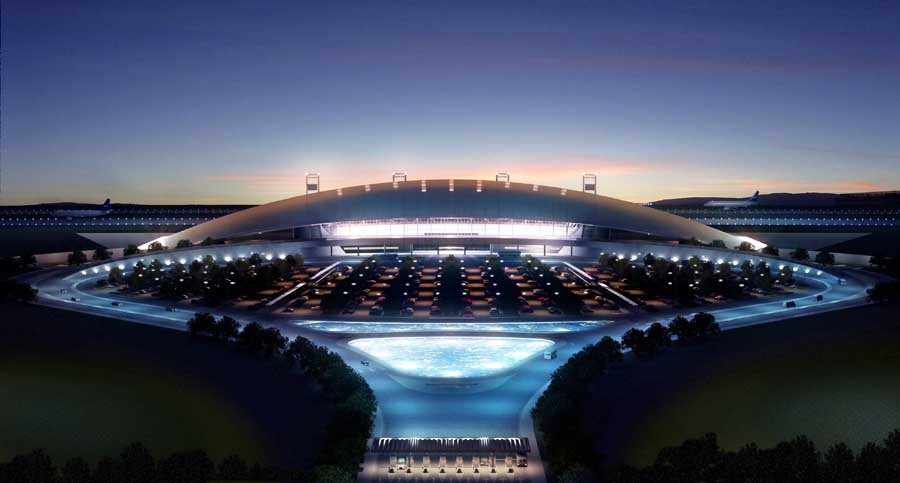 |
Carrasco International Airport
photo by Daniela Macadden |
For one, the amazingly rebuilt Tres Cruces bus terminal was astoundingly modern (it apparently burned a year ago, and to see it in its current condition is quite amazing). In fact, it was significantly more modern than any other bus terminal I had been to in South America, North America, and Europe. I was suspicious of this because it seems that some countries make their transportation centers modern in order to make the foreign visitor feel at home. So again, why the modern facility and the poor neighborhoods?
I had the same question when I saw the airport, which in itself is probably the prettiest airport I had ever seen. In fact, seeing the airport initially confirmed my suspicions that Uruguay was spending a lot of money to keep people coming back to places like Punta del Este by providing them with a seamless transition from transportation to hotel. But then I started noticing the houses and the cars. I noticed the cars first in Montevideo, and then the houses outside of town toward the airport. When travelling in a poor country, it is expected to see old cars. Why? Well, how can a poor person afford a new one? The truth is, the cars on the road would have been what I would have been in the market for had I still been living in the northeastern section of the United States. In fact, I saw my own model on the road fairly often. I wasn't making millions at home, but I was doing OK and my car fit my salary. There were
loads of these cars on the road, and that was what made me think that it wasn't Uruguay that was poor but more that Montevideo is a crap town (again, despite what my friend says about the old part of town that I never got to see).
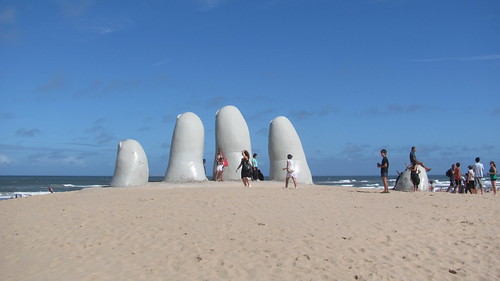 |
The Drowning Swimmer sculpture at La Playa Brava,
Punta del Este |
So we only had four days for Uruguay, and really three of those were reserved for travel. Sunday was going to take us all day to get from Buenos Aires to Manantialles, which is about twenty minutes north of Punta del Este. We had all day on Monday to play in Punta before hopping on two different buses on Tuesday to Colonia del Sacremento, which on the other side of Montevideo from Punta. On Wednesday, we were scheduled to return to Buenos Aires where my two friends were heading north to Iguazu Falls and I was flying back to Santiago de Chile. We all figured this would be an OK schedule, but for me it definitely was not. I wanted more time in all places Uruguay. In fact, if I ever return, I'll return for at least a month, but at the very least, our time was short and we didn't feel guilty skipping over Montevideo this time around.
 |
| La Barra |
Punta del Este is another world, at least it was for me. Other than living in Hawaii when I was young and visiting a few outcast family members living in California, I had never really been to a beach resort town. Yes, I've been to Curacao and to Greece, and I have visited Florida, too, but none of the places I actually went to were destinations. Punta is a destination with big surf on one side of the peninsula and a calm sea on the other. Fancy houses and tall, luxury towers lined the beaches with fast cars humming along the ramblas and big yachts floating just off shore. We were a little late in the season for there to be too many hot bikinis in action (we were there in late Feb when the families tend to show up), but the lights that light up the streets where the food is eaten slowly over wine and drinks told me that this is a place worth coming to in January when both the air and the sights are hot.
 |
| Bikini Beach in La Barra at sunset |
Our hostel was in Manantialles, on the other side of La Barra from Punta, and it is quieter over there than it is on the Punta side of things, but even then there was still enough to garner our interests and keep us occupied. The truth is that I prefer the quiet life, so I was happy there, but I still have a bit of playboy in me, even if I don't like hitting the dance clubs until
four six in the morning. The mixture of the quiet side with the fast side made things definitely good for me, particularly to return to, as well. We sat on the beach all day on Tuesday and had probably the best dinner, drinks, and dessert on the entire trip Monday night. And let's be clear about one thing, the mixed drinks, as we found out, are
much stronger in Uruguay than they are in Buenos Aires.
 |
| Colonia del Sacremento |
After a great two nights in Punta, we awoke to some controversy on Tuesday. I had already bought my tickets to Colonia the night before while my friends steadfastly refused to do so at the same time. They won't admit it, but when it was discovered that the alarm clock was an hour slow, and when I had to rush to catch my bus at ten-thirty, they stayed behind figuring it wasn't worth rushing to miss a bus when their tickets hadn't even been bought yet. I ended up missing the bus, but thankfully COT, the bus company, agreeably changed my ticket to the eleven o'clock bus for free. I figured this would give my friends time to meet up and we'd still catch the same bus. Well, eleven came and went and I was alone on my away to Montevideo. Even then I held out hope that we'd get on the same bus to Colonia because even the twelve o'clock bus from Punta would get them to Montevideo in time for the two-thirty to Colonia. But I ate my lunch alone and got a good deal of writing done before I was on the next bus alone, again. I figured they'd then show up in the early evening, but then I remembered that one of the friends told me not to wait at the bus station in Colonia for them.
"Hmmm..." I thought.
 |
| The plaza below the lighthouse |
OK, so I wasn't that naive. I made the assumption the night I bought my ticket that they wanted an extra day in Punta. As it turned out, I was correct. Again, they won't admit to having planned that, but really, there's more truth to that than there is falsity. They finally showed up,
significantly browner than the day before, at about ten o'clock that night, well after I had seen what I wanted to see in Colonia.
 |
| A typical street in Colonia |
But enough of that, what of Colonia del Sacremento? The town is only an hour's boat ride from Buenos Aires, making it a popular day-trip from the bustling city to the south. And why would one go to Colonia for just one day? I don't know, to be honest, because I felt that with the five hours I had that it wasn't enough. Colonia is a very old, small city (or large town) right on the water. Its cobblestoned streets and tilting brick buildings, with its working lighthouse that one can climb to the very top of, and it's trees overhanging the lamp-light streets, made me feel as romantic as I've ever felt in a place before. The downtown area can easily be done in a day, but why stay for only one day? Bring that special lady (or guy) with you and spend more time enjoying the quiet hours under the yellow tint of the street lamps than racing from place to place. Walk for an hour and stop for lunch. Then walk another hour and grab a coffee or a glass of wine at another petite cafe somewhere in a neighborhood that could be anywhere in Italy. Take the days and enjoy the coastline, which I unfortunately did not have a chance to do. Snap lots of pictures that will certainly end up framed on walls that the grandkids will fight over years later. That is what Colonia was to me. I really regret only giving myself one day to explore it.
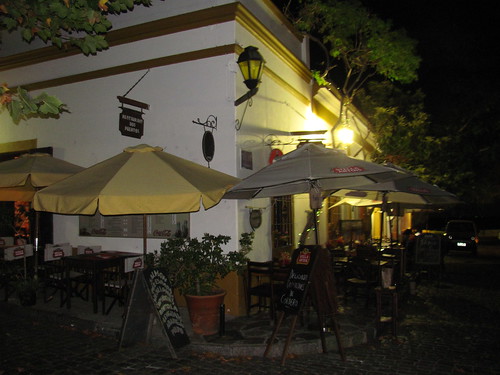 |
| A quiet cafe at night |
In fact, I regret only giving myself one day to explore Punta as well, or even just a few days to explore Uruguay. I would have loved to have gone north to the quieter beaches north of Paloma (some of which are so remote that one can only get there by dune buggy, walking, or on horseback). In fact, I'd also like to go into the center to Duranzo or Tacuarembo, but that will have to be saved for another time. Until now, I carry with me over 200 photos, four days, and a yearning to return someday.
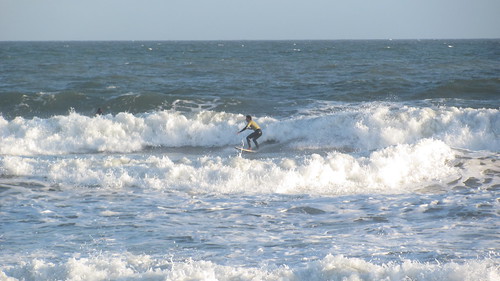 |
| Surfing near Punta del Este |












I must to admit: your text is good. :)
ReplyDeleteGracias!
ReplyDelete